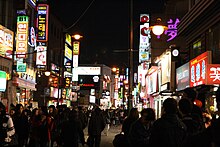Daehangno
- Machine translation, like DeepL or Google Translate, is a useful starting point for translations, but translators must revise errors as necessary and confirm that the translation is accurate, rather than simply copy-pasting machine-translated text into the English Wikipedia.
- Do not translate text that appears unreliable or low-quality. If possible, verify the text with references provided in the foreign-language article.
- You must provide copyright attribution in the edit summary accompanying your translation by providing an interlanguage link to the source of your translation. A model attribution edit summary is
Content in this edit is translated from the existing Korean Wikipedia article at [[:ko:대학로 (서울)]]; see its history for attribution. - You may also add the template
{{Translated|ko|대학로 (서울)}}to the talk page. - For more guidance, see Wikipedia:Translation.
 Daehang-no at night | |
| Korean name | |
|---|---|
| Hangul | 대학로 |
| Hanja | 大學路 |
| Revised Romanization | Daehangno |
| McCune–Reischauer | Taehangno |
| Formerly known as | |
| Hangul | 숭교방 |
| Hanja | 崇敎坊 |
| Revised Romanization | Sunggyobang |
| McCune–Reischauer | Sungkyopang |
Daehang-no (Korean: 대학로; lit. college street) is a area in Jongno District within Downtown Seoul.
Formerly known as Sunggyo-bang (숭교방; 崇敎坊; lit. high respect for teaching), it received its current name after the 1.1 km six lane road from Hyehwa-dong rotary to Ihwa-dong crossroad was designated as a "street of culture" on May 5, 1985.[citation needed]
Daehang-no is the street from the crossroad of 79–1, Jongno 5-ga, Jongno District, to Hyehwa-dong rotary, 132, Hyehwa-dong.[citation needed]
History
King Taejo relocated Sungkyunkwan to the current location on Daehang-no, after the founding of the Joseon dynasty. This gave Daehang-no its former name, "Sunggyo-bang", meaning "high respect for teaching".[citation needed]
During the Japanese occupation, Keijō Imperial University was founded in this area. The university was later merged with other colleges to form the prestigious Seoul National University.[citation needed]
In March 1975, main campus of the Seoul National University was moved to Gwanak District by pressure from national government.[1] What came to the place where SNU left, was densely concentrated theatre district around Marronnier Park,[2] as the street was hub of Seoul's university culture in 1970s.[3]
See also

Notes and references
- ^ Han, Eun-hwa (13 March 2018). "Daehangno icon becomes a hub of innovation". Korea Joongang Daily. Seoul. Retrieved 2024-06-25.
- ^ Moon, Gwang-lip (20 July 2009). "A street where dreams come to life". Korea Joongang Daily. Seoul. Retrieved 2024-06-25.
- ^ Garcia, Cathy Rose A. (13 March 2018). "Arko Art Center Celebrates 30 Years in Daehangno". The Korea Times. Seoul. Retrieved 2024-06-25.
External links
- Daehangno– Seoul’s Theater District: Official Seoul City Tourism
- Jongno-gu local government website
- v
- t
- e
| North of the Han River (Gangbuk) | |
|---|---|
| South of the Han River (Gangnam) |

- Downtown Seoul (Central Business District, CBD)
- Gangnam Business District (GBD)
- Yeouido Business District (YBD)
37°34′37″N 127°0′7″E / 37.57694°N 127.00194°E / 37.57694; 127.00194










